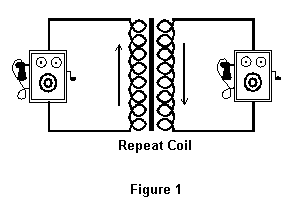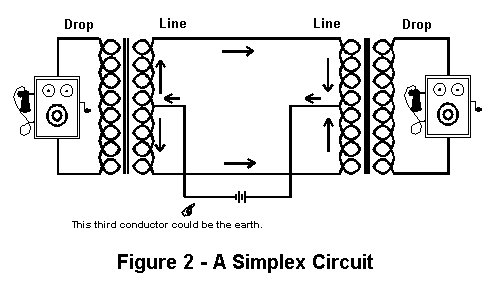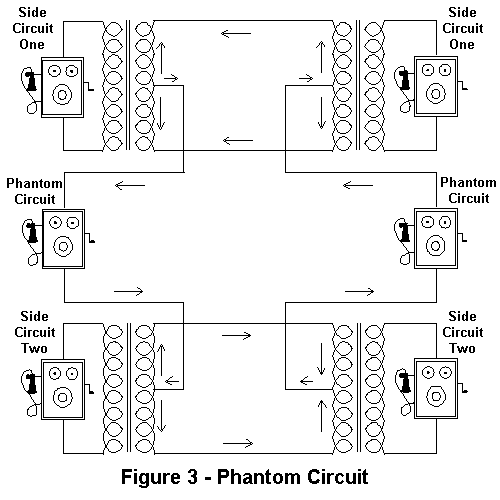
Telephone Collectors International
The Phantom Circuit
Last update May 14, 2015
 | Telephone Collectors InternationalThe Phantom Circuit | First Posted Apr 22, 2000 Last update May 14, 2015 |
from the March 1998 issue of Singing Wires Journal newsletter
by Paul Wills
This is an arrangement of repeat coils used to obtain three telephone circuits from two pairs of wires.
One goal of a business is to obtain the maximum amount of income from its assets. Since the wire and cable plant makes up a considerable part of a telephone company's assets, it's easy to see why great efforts are taken to maximize the amount of traffic that the plant can handle. Of course, in these days of digital carrier, it's hard to consider that there was a time when the telephone industry would gladly welcome any opportunity to add just one more circuit to their existing lines. The Phantom Circuit is one clever method of doing this. Hopefully this discussion will not only familiarize the reader with the phantom circuit but also vividly present a picture of just how much could be done with the "primitive" technology of the past.

To understand the workings of a phantom circuit, one must first understand the operation of the audio transformer or "Repeat Coil" as the telephone industry likes to call it. For our purposes, a repeat coil simply consists of two lengths of wire wound around a core consisting of a permeable material. (I could have said an iron or nickel core but since Bell Labs developed all of those nice alloys, I had to be inclusive!) Although the number of turns around the core of each winding may differ, (this is how a transformer changes voltages), for the purpose of this discussion, we will say that they are the same. Thus, when an Alternating Current (AC) signal is applied to one winding, an equal AC signal is induced on the other winding. Since telephone voice and ringing signals are AC, there is no reason why two local battery or "dry" telephone lines can't be connected together through a repeat coil. (Figure 1) Any current applied to one side of the repeat coil will appear on the other side.

Consider a typical telephone circuit with a repeat coil on each end. (Figure 2) Note that the Line winding is the one that is connected to the line. The Drop winding is connected to the telephone equipment. What would happen if a connection were made at the midpoint of each of the Line windings? Nothing, as far as the telephone circuit is concerned. Currents applied to the Drop winding of one end of the circuit will still appear on the Drop winding at the opposite end of the circuit. The trick is to apply a current to the midpoint. If the two wires are equal in resistance, a current applied to the midpoint of the Line winding of one repeat coil will divide equally and travel down each wire to the Line winding of the other repeat coil where they will combine again. Since the two currents flow through the Line windings of each repeat coil in opposite directions, they cancel each other out and, thus, no current is induced on the Drop windings. If the earth is used to complete the circuit, it is possible to add a second function, such as a Morse telegraph line, to the single telephone pair without affecting the operation of the telephone circuit. This is called a Simplex Circuit.

If two simplex circuits are combined as shown in Figure 3, a third telephone circuit can be obtained over two pairs of wires. This third circuit is the phantom circuit. As long as the resistance of each wire in a pair is equal to the other wire, conversations carried over the phantom circuit will not appear on either of the two original circuits. (These are called Side Circuits.) Conversely, conversations on either side circuit will not appear on the phantom circuit. The benefit: for the cost of four repeat coils, two "*virtual" wires are added. And if that's not enough, because a phantom circuit operates over two pairs of wire, it has less resistance and, thus, "talks" better. The only drawback: a high resistance splice or grounded wire in a side circuit will cause all kinds of cross talk so the line must be kept in excellent condition.
If a telephone company was not happy with a gain of one circuit from two pairs, they could always take two phantom circuits, additional repeat coils and "phantom the phantoms" to obtain seven circuits over four pairs of wire. Thus, Ghost and Wraith pairs were created but I probably should stop there. It's getting late, I hear a strange tapping on the window, the lights are going out one by one and I hear the sounds of rattling chains coming up the stairs...
*that should make the computer literate folks happy!